Welcome to the enchanting world of Begonia Black Magic, a botanical wonder that has captured the hearts of plant enthusiasts around the globe. This begonia variety, known for its mysterious allure and captivating aesthetics, stands out with its deep, velvety foliage and unique characteristics.
Begonia Black Magic, scientifically classified under the Begoniaceae family, is a hybrid plant resulting from careful crossbreeding to accentuate its rich, dark hues. Its botanical name, Begonia rex-cultorum ‘Black Magic’, gives a nod to both its regal appearance and the magical ambiance it brings to any space.
With leaves that exhibit shades of deep purple and almost black, this begonia variety adds a touch of drama and elegance to your indoor or outdoor garden. The leaves, which are often asymmetrically shaped, showcase a vibrant pattern of silver swirls, creating a mesmerizing contrast against the dark backdrop. As a rhizomatous begonia, the Black Magic is known for its thick stems, and its growth habit makes it a striking focal point in any collection.
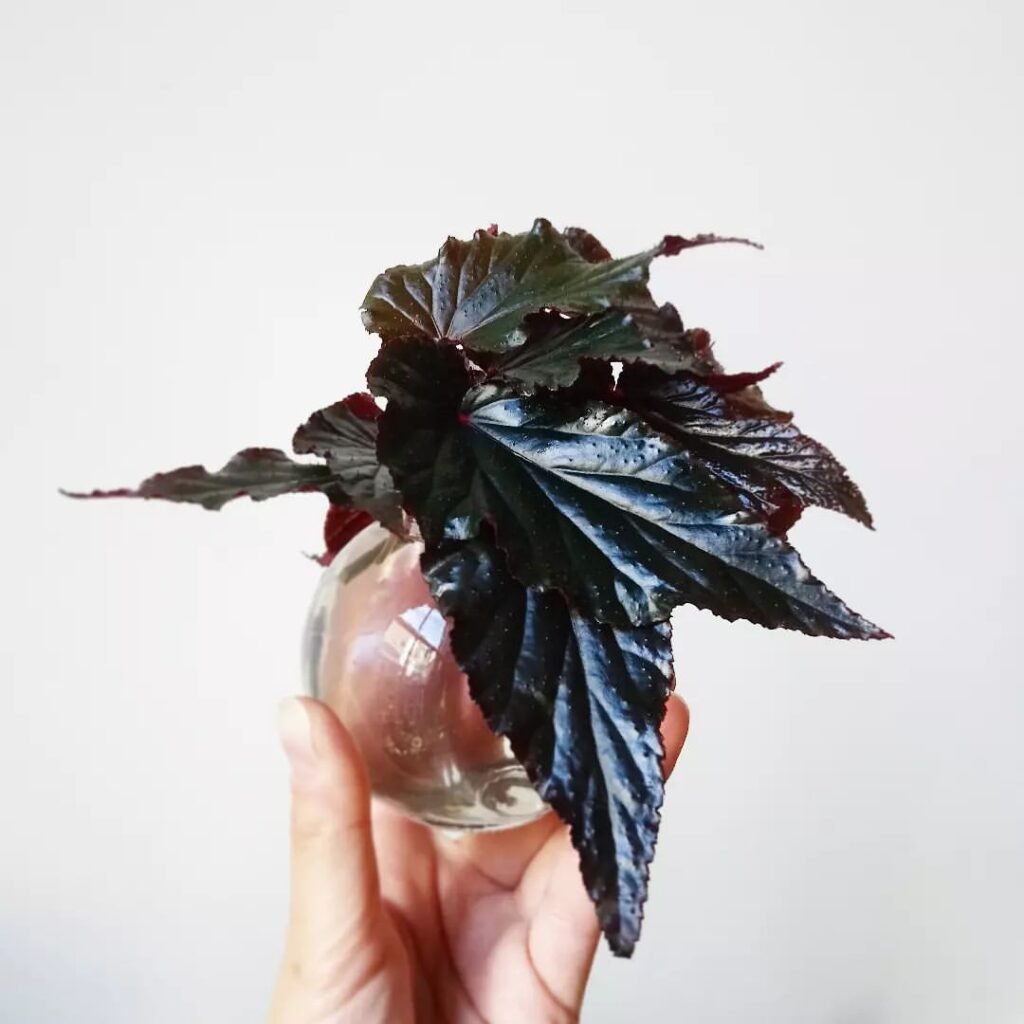

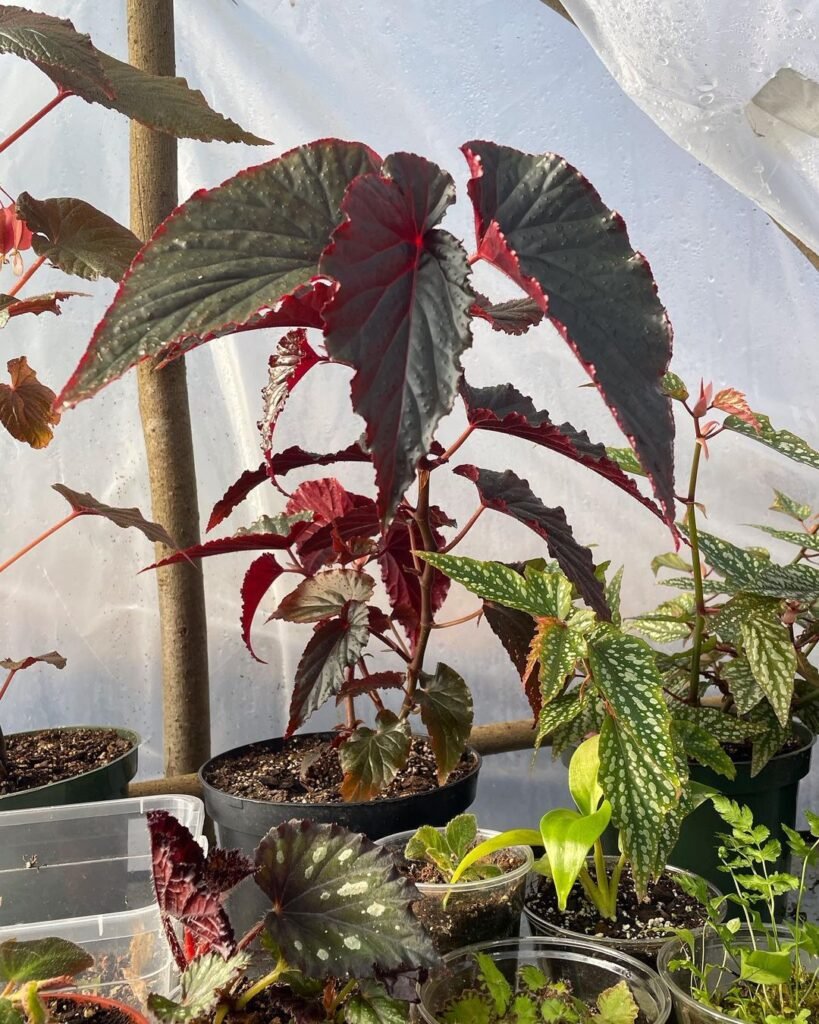
Begonia Black Magic Care Guide Overview
Begonia Black Magic, though captivating in its appearance, requires a thoughtful approach to care to ensure it thrives in your botanical haven. Here’s a quick overview to guide you through the essentials:
| Aspect | Details |
|---|---|
| Light Requirements | Prefers bright, indirect light; avoid direct sun. |
| Soil Type | Well-draining potting mix rich in organic matter. |
| Watering Frequency | Keep soil consistently moist but not waterlogged. |
| Humidity Levels | High humidity preferred; mist leaves regularly. |
| Temperature Range | Warm temperatures between 65°F to 75°F (18°C to 24°C). |
| Fertilizing | Feed with balanced liquid fertilizer every 2-4 weeks. |
| Pruning Needs | Minimal pruning; remove dead or damaged leaves. |
| Propagation | Propagate through leaf or stem cuttings. |
| Repotting | Repot every 1-2 years or when outgrowing the pot. |
| Seasonal Care | Adjust care routine based on seasons. |
Genus Species & Appearance



The begonia genus is vast and diverse, encompassing numerous species and hybrids. Begonia Black Magic belongs to the rex-cultorum group, known for its stunning foliage and striking leaf patterns. Within this group, the Black Magic variety stands out for its dark, velvety leaves that create a visually arresting display.
The leaves of Begonia Black Magic are typically asymmetrical, with irregular edges that add to the allure of the plant. The deep purple to almost black coloration provides a dramatic contrast, making it a coveted choice for those seeking a touch of sophistication in their plant collection.
As a rhizomatous begonia, Begonia Black Magic produces thick stems that store water, contributing to its ability to withstand brief periods of drought. This characteristic, coupled with its preference for high humidity, makes it well-suited for indoor environments.
Not the plant for you? Check out my full list of 78 Types of Begonia!
Light and Soil Requirements
Creating the ideal environment for your Begonia Black Magic involves a delicate dance with light and soil. These two factors play a pivotal role in nurturing the captivating allure of this mysterious plant.
Lighting Magic:
In the world of Begonia Black Magic, light is not just a necessity; it’s a key player in enhancing the drama of its deep, velvety foliage. This begonia variety thrives in bright, indirect light, mimicking the dappled sunshine it might encounter in its native habitat. While it loves light, direct sun can be a bit too much for its delicate leaves, so finding that sweet spot is essential.
Position your Black Magic where it can bask in filtered sunlight, perhaps near a sheer curtain or under the canopy of larger plants. Think of it as finding the perfect spotlight to showcase its enchanting performance.
Soil Symphony:
The soil beneath your begonia’s roots is like the stage where the magic happens. Begonia Black Magic prefers a well-draining potting mix rich in organic matter. Imagine a soil composition that’s not too heavy, allowing water to flow through, yet substantial enough to cradle those thick rhizomatous stems.
A mix of peat moss, perlite, and a touch of loamy goodness sets the stage for optimal growth. Consider potting your Black Magic in a container with drainage holes, allowing excess water to make a graceful exit and preventing the soggy drama that begonias dislike.
Watering
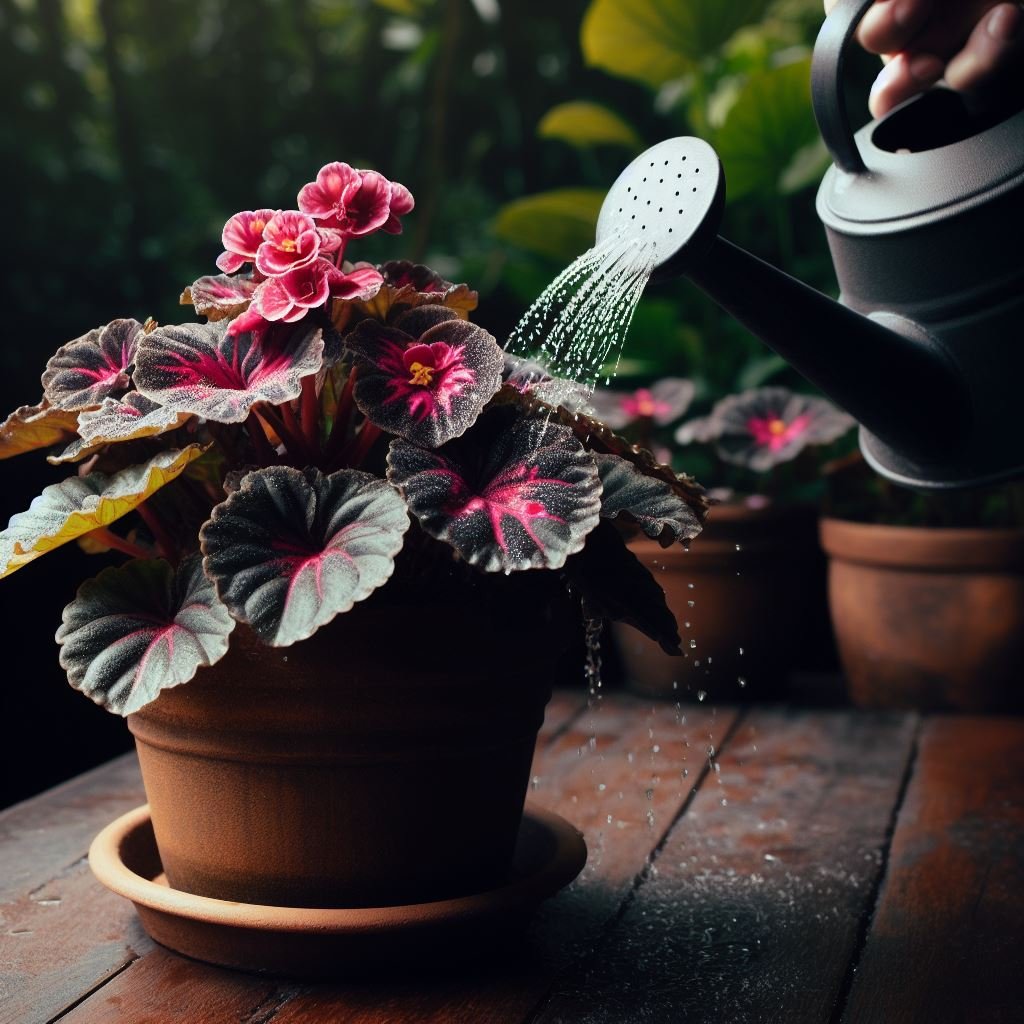
The art of watering a Begonia Black Magic is akin to orchestrating a delicate dance. Too much, and you risk drowning the drama; too little, and the leaves might droop in protest. Finding that perfect rhythm involves understanding the nuances of your begonia’s hydration needs.
Moisture Maestro:
Picture your Black Magic as a diva with a preference for consistently moist soil. Unlike some temperamental plants, this begonia doesn’t appreciate droughts or soggy roots. Keep the soil consistently moist but not waterlogged, finding the right balance between hydration and aeration.
When you water, imagine you’re providing a refreshing drink rather than unleashing a torrent. Allow the top inch of the soil to dry out before the next performance, preventing waterlogged conditions that can lead to root rot.
Humidity Serenade:
In the world of Begonia Black Magic, high humidity is the secret sauce for vibrant foliage. Mimic the misty ambiance of a tropical rainforest by regularly misting the leaves. This not only keeps the diva happy but also adds a touch of mystique to your plant care routine.
As you engage in this rhythmic watering dance, you’ll witness your Black Magic thriving, its leaves unfurling like a captivating performance on the botanical stage.
Humidity and Temperature
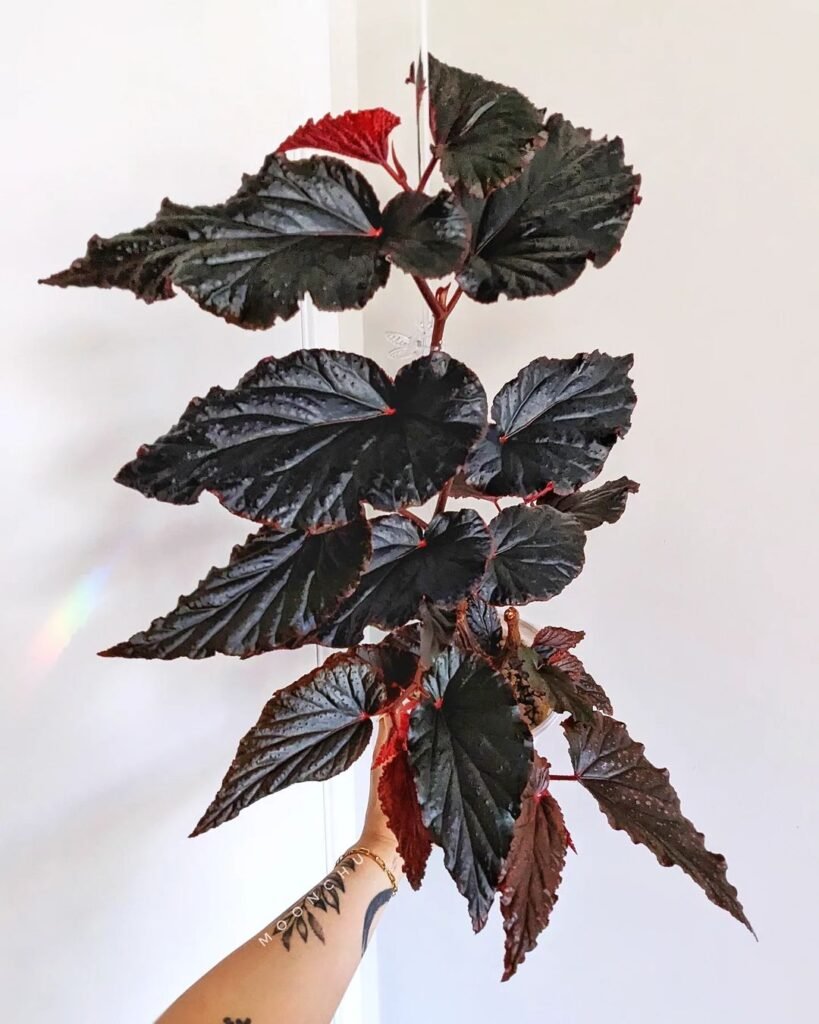


Creating a cozy microclimate for your Begonia Black Magic involves mastering the delicate balance of humidity and temperature. These environmental factors contribute to the enchanting performance of this captivating begonia.
Humidity Harmony:
In the begonia realm, high humidity is the secret ingredient to unlock the full vibrancy of Begonia Black Magic. Imagine the lush tropics where misty mornings and dew-kissed leaves create a magical ambiance. Mimic this by regularly misting the leaves or placing a tray of water near the plant to maintain the desired humidity levels.
Top Tip: If you notice your Black Magic’s leaves developing crispy edges, it’s a gentle reminder to increase the humidity. Consider relocating the plant to a more humid spot or introducing a humidifier to keep the foliage happy.
Temperature Tango:
Picture the ideal temperature for your Black Magic as a comfortable dance floor – not too hot, not too cold, but just right. This begonia variety thrives in warm temperatures, ideally ranging between 65°F to 75°F (18°C to 24°C). Avoid exposing it to sudden temperature drops, drafts, or chilly windowsills.
Care Tip: During colder months, shield your Black Magic from the chill by placing it away from cold windows and providing a bit of extra warmth. Consider using a plant heat mat to maintain a cozy environment, ensuring your begonia stays snug and vibrant.
Fertilizing
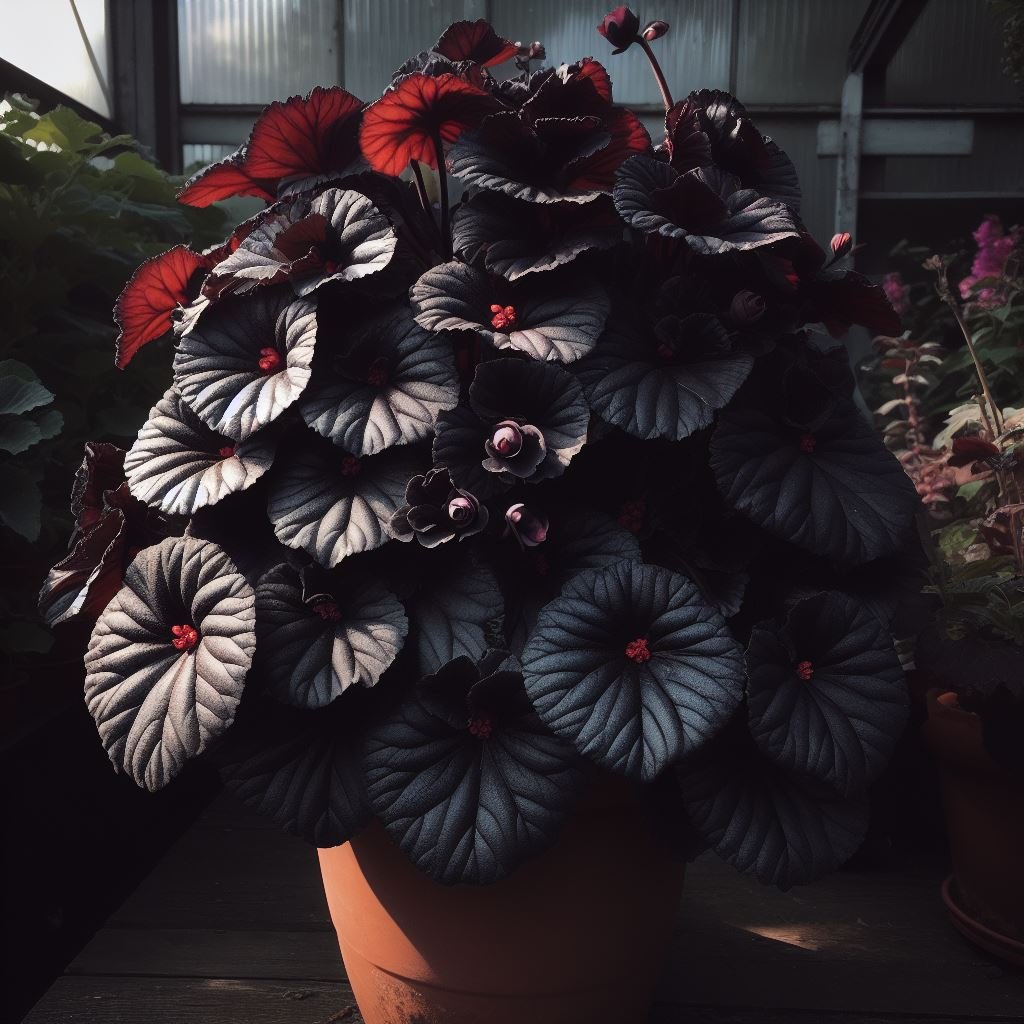
Feeding your Begonia Black Magic is like providing it with a gourmet meal – a carefully crafted blend of nutrients to support its growth and enhance its botanical charisma.
Balanced Banquet:
This begonia variety appreciates a well-balanced liquid fertilizer, creating a feast for its roots every 2-4 weeks during the growing season. Imagine this fertilizer as a nutritional cocktail, offering a bit of everything your Black Magic needs for a flourishing performance.
Nourishment Note: Before applying fertilizer, ensure the soil is moist to prevent any potential stress on the roots. Consider diluting the fertilizer to half strength to avoid overfeeding, allowing your begonia to savor the nutrients without overwhelming its delicate palate.
Seasonal Specials:
Adjusting the feeding routine based on the seasons is like tailoring a menu to suit changing tastes. During the active growing season, from spring to early fall, your Black Magic craves more nutrients. As winter approaches, reduce the frequency to accommodate its natural slowdown.
Numbered Nurturing:
- In spring, provide a boost of fertilizer as new growth emerges.
- Summer calls for regular feeding to support the begonia’s peak performance.
- As fall approaches, gradually reduce fertilizing to prepare your plant for a restful winter.
Pruning and Shaping
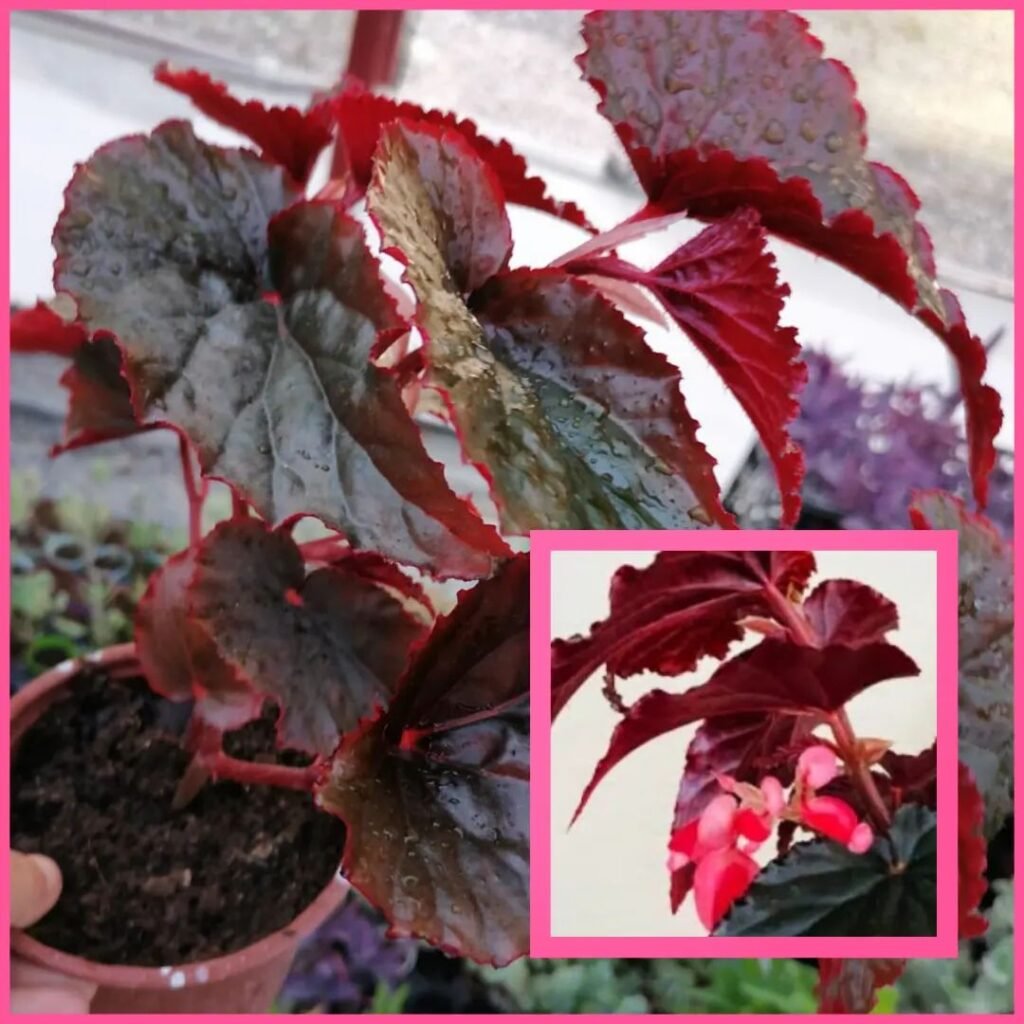
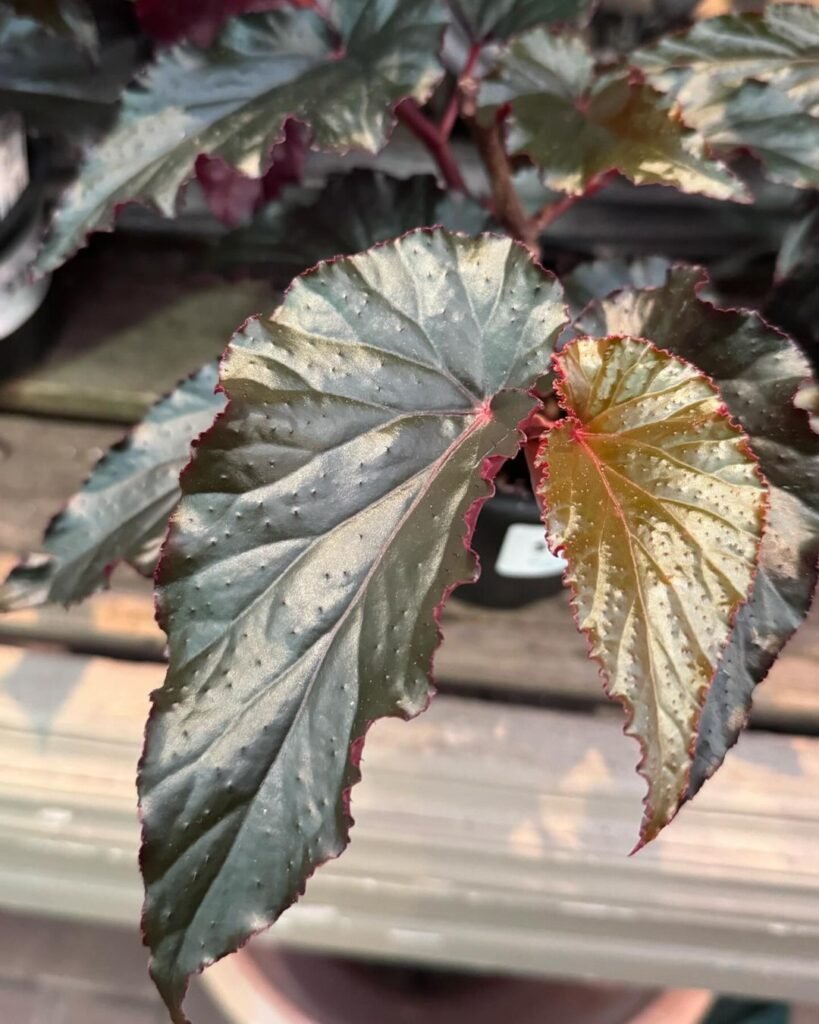

Pruning and shaping your Begonia Black Magic is like sculpting a botanical masterpiece. This practice not only enhances the plant’s aesthetics but also promotes healthier growth and maintains its enchanting allure.
Pruning Precision:
When it comes to pruning Begonia Black Magic, think of it as a refined haircut to remove any dead, damaged, or leggy growth. Use sharp, clean scissors or pruning shears to make precise cuts just above a leaf node. This not only tidies up the appearance but also encourages the emergence of new shoots.
| Type of Pruning | Timing | Purpose |
|---|---|---|
| Deadheading | Throughout the year | Remove spent flowers to encourage continuous bloom |
| Selective | Spring or early summer | Shape the plant and remove unhealthy growth |
| Hard Pruning | Late winter or spring | Renew older plants and stimulate fresh growth |
Shaping Elegance:
Shaping your Black Magic is akin to crafting a living sculpture. Embrace the natural growth pattern of your begonia, guiding it with gentle adjustments. Pinch back the tips to encourage bushier growth and create a more compact, well-balanced silhouette.
Care Tip: If your Black Magic starts to outgrow its space, consider repotting and shaping it simultaneously. This not only refreshes the soil but also allows you to redefine its form.
Propagation and Repotting
Expanding your collection of Begonia Black Magic and refreshing its living quarters involves the delicate processes of propagation and repotting. These steps ensure the continued vibrancy of your begonia.
Propagation Prowess:
Propagating your Black Magic can be a rewarding journey. The primary methods include stem cuttings and leaf cuttings. Choose healthy, disease-free stems or leaves, and place them in a well-draining propagation mix. Mist the cuttings regularly to maintain high humidity, and soon you’ll witness the magic of new growth.
Leaf Propagation:
- Select a healthy leaf with a short stem.
- Trim the stem just below a leaf node.
- Place the leaf, cut-side down, in a propagation mix.
- Keep the soil consistently moist, and roots will develop in a few weeks.
Repotting Ritual:
As your Black Magic matures, it may outgrow its current home. Repotting not only provides a fresh start but also allows you to refresh the soil and address any overcrowded roots. Choose a container with drainage holes, and use a well-balanced potting mix.
| Age of Begonia | Repotting Frequency |
|---|---|
| Young (<1 year) | Annually |
| Mature (1-2 years) | Every 2 years |
| Established (>2 years) | Every 2-3 years |
Seasonal Care
Navigating the changing seasons with your Begonia Black Magic involves adjusting your care routine to cater to the plant’s natural rhythms. Each season brings unique challenges and opportunities, allowing you to foster optimal growth and vitality.
Seasonal Transitions:
- Spring Awakening: As the days lengthen and temperatures rise, increase watering frequency and resume regular fertilization. Monitor for new growth and adjust pruning as needed.
- Summer Splendor: During the peak of summer, ensure your Black Magic is shaded from intense midday sun to prevent leaf scorch. Continue misting to maintain humidity levels, and keep an eye out for pests.
- Autumn Retreat: As the days shorten, gradually reduce fertilization and prepare your begonia for a period of dormancy. This is also an excellent time for any necessary repotting.
- Winter Rest: In the colder months, your Black Magic may enter a resting phase. Reduce watering but ensure the soil doesn’t completely dry out. Shield it from drafts, and consider moving it to a warmer location if needed.
Companion Plants
Choosing the right companions for your Begonia Black Magic is like curating a harmonious botanical ensemble. Selecting plants that complement its needs and aesthetics creates a captivating garden tapestry.
Foliage Complements:
Pairing your Black Magic with plants that boast contrasting foliage can elevate the visual appeal of your garden. Consider companions with vibrant greens, silvers, or even variegated patterns. The begonia’s deep, velvety leaves create a stunning backdrop, allowing its companions to shine.
Dynamic Duos:
- Silver Falls (Dichondra argentea): This trailing silver-leaved plant complements the dark foliage of Black Magic, creating a striking contrast.
- Nerve Plant (Fittonia): With its intricate leaf patterns, the nerve plant adds a touch of elegance to the ensemble.
Height Harmony:
Playing with height variations adds a dynamic dimension to your garden. Taller companions can provide shade for your Black Magic, while shorter plants accentuate its beauty at eye level.
Strategic Arrangements:
- Bamboo Palms (Chamaedorea): Tall and graceful, these palms provide a lush, tropical backdrop.
- Creeping Jenny (Lysimachia nummularia): Low-growing with trailing stems, it complements the Black Magic’s cascading growth.
Seasonal Symphony:
Introducing plants that bloom at different times ensures your garden is a year-round spectacle. Pairing your begonia with seasonal bloomers creates a rotating display of colors and textures.
Seasonal Showstoppers:
- Spring Delight – Tulips and Daffodils: Plant bulbs around your Black Magic for a burst of spring color.
- Summer Stars – Marigolds and Petunias: These vibrant summer blooms add a pop of color.
- Autumn Accents – Chrysanthemums: Choose mums for a fall flourish around your begonia.
By curating a garden ensemble with these considerations, you’ll create a captivating botanical display where each plant enhances the beauty of the other. Now, let’s explore effective pest control tips to ensure your begonia remains in optimal health.
If you’re thinking of extending your begonia plant family, I recommend reading up on amstel begonia and begonia blancii. They both make great additions to your squad!
Pest Control Tips
Protecting your Begonia Black Magic from pests is a crucial aspect of its care routine. Vigilance and strategic measures can prevent infestations and keep your begonia thriving.
Inspect and Isolate:
Regularly inspect your Black Magic and nearby plants for any signs of pests. If you spot any unwelcome visitors, promptly isolate the affected plant to prevent the infestation from spreading.
Common Pests:
- Aphids: Small, sap-sucking insects that cluster on new growth.
- Spider Mites: Tiny pests that create webbing and cause stippling on leaves.
- Mealybugs: Cottony masses on stems and leaves, draining plant sap.
Natural Defenders:
Introduce beneficial insects that act as natural predators for common pests. Ladybugs, lacewings, and predatory mites can help keep aphid and mite populations in check.
Companion Planting:
- Marigolds: Known for repelling nematodes, they can contribute to overall pest prevention.
- Basil: Aromatic basil can deter certain pests and improve the health of neighboring plants.
Homemade Remedies:
Prepare simple homemade solutions to deter pests. A mild solution of dish soap and water can be sprayed on leaves to combat aphids. Neem oil is another effective and natural option for controlling a variety of pests.
Careful Application:
- Dish Soap Solution: Mix 1 teaspoon of mild dish soap with 1 liter of water. Spray on affected areas.
- Neem Oil: Dilute neem oil following package instructions and apply with a sprayer.
By incorporating these pest control strategies into your care routine, you’ll ensure your Begonia Black Magic remains a flourishing focal point in your garden.
Reviving a Sick or Wilting Begonia Black Magic
Reviving a Begonia Black Magic on the brink requires a thoughtful diagnosis and targeted intervention. Recognizing the signs of distress and implementing corrective measures can bring your begonia back to vibrancy.
Diagnostic Detective:
Identifying the root cause of your begonia’s decline is the first step in the revival process. Assess the following factors:
Table: Signs of Distress and Possible Causes
| Signs of Distress | Possible Causes |
|---|---|
| Wilting Leaves | Overwatering, underwatering, root rot. |
| Yellowing Foliage | Lack of nutrients, poor soil drainage. |
| Leaf Spotting | Fungal or bacterial infections. |
| Stunted Growth | Improper lighting or nutrient deficiency. |
Emergency Care Plan:
Once you’ve identified the issue, implement targeted care measures to address the specific problem. Adjust watering frequency, ensure proper lighting, and consider repotting if root health is compromised.
Revival Tips:
- Wilting Leaves: Check soil moisture; adjust watering accordingly. Trim any affected leaves.
- Yellowing Foliage: Assess soil drainage; consider fertilizing with a balanced mix.
- Leaf Spotting: Isolate the plant, prune affected leaves, and apply a fungicide if necessary.
- Stunted Growth: Evaluate lighting conditions and consider adjusting fertilization.
Patience and Persistence:
Reviving a distressed begonia takes time, and not all interventions yield immediate results. Monitor your Black Magic closely, continue with adjusted care practices, and be patient as it regains its strength.
Conclusion
In the captivating journey of cultivating and caring for Begonia Black Magic, we’ve explored the intricacies of creating an ideal environment for this enchanting plant. From understanding its beguiling appearance to mastering the art of care, each aspect contributes to the thriving performance of this botanical gem.
Begonia Black Magic, with its deep, velvety foliage and striking characteristics, adds a touch of drama and sophistication to any garden or indoor space. As we navigated through the care guide, we discovered the importance of lighting magic, the symphony of soil composition, and the rhythmic dance of watering.
The exploration extended to the delicate balance of humidity and temperature, the nourishing banquet of fertilizing, and the artistic practices of pruning and shaping. Propagation and repotting, the seasonal care nuances, and the selection of companion plants all played vital roles in creating a harmonious and thriving environment for the Black Magic.
FAQs
How often should I water my Begonia Black Magic?
Watering frequency depends on factors like temperature, humidity, and soil. Keep the soil consistently moist but not waterlogged, and adjust based on the plant’s specific needs.
Can I grow Begonia Black Magic outdoors?
While Black Magic thrives indoors, it can also be grown outdoors in shaded or partially shaded areas. Ensure it’s protected from direct sunlight and harsh weather conditions.
What should I do if my begonia’s leaves turn yellow?
Yellowing leaves may indicate issues such as nutrient deficiency or poor drainage. Assess the soil, consider fertilizing, and address any drainage concerns promptly.
How do I propagate Begonia Black Magic?
Propagate through stem or leaf cuttings. Choose healthy, disease-free parts, plant in a well-draining mix, and provide high humidity for successful propagation.
Why are there spots on my begonia’s leaves?
Leaf spotting can be caused by fungal or bacterial infections. Isolate the plant, prune affected leaves, and consider applying a fungicide as needed.

Writer/Green Thumb/Explorer – Rooted deep in the rich soils of Devon, I’ve cultivated a vast expertise in plant care, helping greenery thrive in homes across the UK. When I’m not crafting detailed plant care guides, I’m journeying through the lush landscapes of the West Country, unearthing nature’s secrets and sharing them with fellow plant enthusiasts. Every leaf has a story, and I’m here to tell it.





